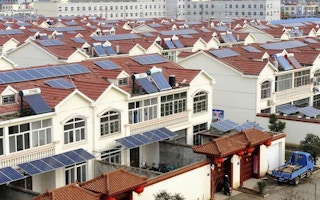China, the world’s biggest solar market for two years running, is pushing to install more panels at factories, schools and even greenhouses as it seeks to meet its goals under a historic climate agreement with the US.
China expects to install as much as 8 gigawatts of small solar systems this year, more than 10 times what was built last year. The country had almost 20 gigawatts of solar capacity at the end of 2013, a figure comparable to about 20 nuclear reactors. Most of that came from massive solar farms in remote locations and policy makers are now promoting smaller systems closer to where they’re needed.
The push to promote wider use of rooftop solar comes amid growing health concerns tied to smog within its own population and from foreign companies. It also adds to the nation’s push to be a leader within the global climate community.
A Global Push to Save the Planet
The figures show the changes. Coal made up 64 per cent of China’s electricity mix in 2013, down from 68 per cent in 2010, according to Bloomberg data. Solar’s proportion of electricity generation capacity rose to 2 per cent, from 0.08 per cent four years ago, doubling nuclear power’s share last year.
“Solar is actually the most attractive when you do rooftop because it eliminates transmission and distribution investment,” said Ahmad Chatila, chief executive officer of St. Peters, Missouri-based SunEdison Inc.
“
Beijing’s solar policy of concentrating on distributed generation with ongoing tweaks to make it more effective is actually very solid in the mid- to long-term
Charles Yonts, head of sustainable research at brokerage CLSA Asia-Pacific Markets in Hong Kong
Dirtiest air
Producing so much power in isolated areas creates bottlenecks in the grid. So-called distributed power, smaller systems installed locally, eliminates the need for costly transmission cables and will speed the country’s transition away from the coal-fired power plants that help create some of the world’s dirtiest air.
SunEdison is in talks with a Chinese partner to build a factory in the country and agreed last month to jointly create a $220 million fund to develop as much as 1 gigawatt of solar projects there. China’s distributed solar market is going to be “enormous,” Chatila said.
China’s National Energy Administration introduced policies in September aimed at boosting the use of distributed solar power. Companies both in China and in other regions are responding. For instance, Solar Power Inc, a US developer backed by the Chinese manufacturer LDK Solar Co, said it would build 19 megawatts of rooftop systems in Shandong.
The country installed about 13 gigawatts of panels last year, almost matching the total amount of solar power in operation in the US, and 94 per cent of that capacity came from utility-scale projects.
Identifying sites
The agency asked local authorities to identify potential sites for rooftop plants and smaller, ground-mounted projects. These would include industrial and commercial companies with large rooftops, and public buildings such as railway stations and airport terminals. China has set a goal of installing 8 gigawatts of small systems this year and 6 gigawatts for larger projects.
Distributed solar will look different in China, where land is state-owned and single-family houses are still relatively rare. While homeowners are driving the rooftop solar market in the US and Europe, panels in China will be mostly found atop industrial and commercial buildings, as well as vacant lots, greenhouses, intertidal zones and the empty spaces around fishponds and lakes.
Solar bankruptcies
China is expected to add as much as 8 gigawatts of distributed solar systems in 2015, out of 15 gigawatts of total photovoltaic power, according to Bloomberg New Energy Finance.
That forecast has China installing in one year about twice as many panels atop factories, office buildings and other distributed sites as there are currently in operation in Australia, one of the world’s sunniest countries.
Chinese manufacturers sold about $5 billion of shares from 2005 to 2010, and wrested control of the market from companies in the US., Germany and Japan. The added capacity drove down prices and pushed dozens of manufacturers into bankruptcy. Solar panels sell for 72 cents a watt now, compared with $2.01 at the end of 2010. The price has slipped 12 percent this year.
“Beijing’s solar policy of concentrating on distributed generation with ongoing tweaks to make it more effective is actually very solid in the mid- to long-term,” said Charles Yonts, head of sustainable research at brokerage CLSA Asia-Pacific Markets in Hong Kong.
More projects
JinkoSolar Holding Co, China’s third-largest panel maker, arranged in July as much as 1 billion yuan ($161 million) in financing from China Minsheng Banking Corp. for distributed solar. An 88.8 million-yuan loan for a 20-megawatt rooftop solar project in Zhejiang province will be the first under the agreement. JinkoSolar is planning three more projects of comparable size in Jiaxing, also in Zhejiang province.
“Policies are relatively good, and companies are competing for rooftop space,” said Sebastian Liu, Jinko’s director of investor relations. Rooftop projects will account for a third of Jinko’s developments in 2015, up from 10 percent this year.
“Investors have hesitated to start projects in the past because returns weren’t clear,” said Meng Xiangan, vice chairman of the China Renewable Energy Society, which acts as a liaison between the government and industry. Developers “should grasp the opportunities favorable for distributed projects to install more panels.”










